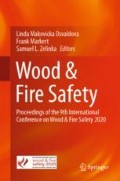Abstract
Not only are signals about smoke and temperature rise, given by fire, but there is also a burnt smell characteristic of fire. Focusing on the odor quality changing, it was applied to fire detection in the early stages. In order to clarify the relationship between changes in odor quality and temperature during oxidation pyrolysis and pyrolysis, the generated odor gas is collected in a sampling bag attached to the exhaust port of the TG-DTA/FT-IR system. FT-IR was used to measure pyrolysis and combustion gases to determine chemical species based on temperature rise rate. The overall odor of the molecules generated by pyrolysis and oxidative pyrolysis in the collected gas every 300 s was then measured using electronic noses. The representation test sample was Japanese cedar. For TG-DTA, the oxygen concentration was set to 0–20% and the temperature rise rate was set to 2–20 K/min. The FT-IR results for the aldehyde group showed a lower temperature at which the absorption peaked than that by the CO. As a result of comparison between odor changes and chemical species during fire combustion, the similarity index of aldehyde groups to the odor at the time of initial fire increased by oxidative pyrolysis. From these facts, in wood and related material it was found that detection of substances based on aldehyde groups among odors generated during pyrolysis and/or combustion can be used as a possibility of fire detection for wooden materials.
Access this chapter
Tax calculation will be finalised at checkout
Purchases are for personal use only
References
Jackson MA, Robins I (1994) Gas sensing for fire detection: measurements of CO, CO2, H2, O2, and smoke density in european standard fire tests. Fire Saf J. 22:181–205
Ryder NL (2017) Multicriteria detection: leveraging building control and comfort sensors for fire state determination. In: Proceedings of the 16th international conference on automatic fire detection I, pp 349–355
Mensch B, Cleary T (2017) A comparison of carbon monoxide gas sensing to particle smoke detection in residential fire scenarios. In: Proceedings of the 16th international conference on automatic fire detection I, pp 363–370
Arndt G, Suchy S, Vialkowitsch D (2017) Multi-criteria/multi-sensor early fire detection in the engine compartment of road vehicles: evaluation process of gas sensors. In: Proceedings of the 16th international conference on automatic fire detection II, pp 47–54
Kohla D, Eberheim A, Schieberle P (2005) Detection mechanisms of smoke compounds on homogenous semiconductor sensor films. Thin Solid Films 290:1–6
Sugawa O, Kamiya K, Oka Y (2014) Evaluation on odor intensity and quality from plastic and wood materials in pre-combustion condition. In: 15th international conference on automatic fire detection, vol 15, pp 21–28
Kamiya K, Sugawa O, Imamura T, Oka Y (2013) Experimental study on odor intensity and quality from wood materials in oxidative pyrolysis. Bull Japan Assoc Fire Sci Eng 63(2):25–35 (in Japanese)
Kamiya K, Sugawa O, Kanai H, Imamura T, Oka Y (2011) Evaluation on odor intensity and quality from wood in pre-combustion condition. In: Proceedings of Asia Pacific symposium on safety, pp 344–347
Tanaka, S Iida Y (1999) Instrumental Analysis, Shikabo, pp 332–338 (in Japanese)
ISO 19702 (2006) Toxicity testing of fire effluents – Guidance for analysis of gases and vapors in fire effluent using FTIR gas analysis
Kita J, Aoyama Y, Kinoshita M, Nakano H, Akamaru H (2000) Technical digest of the 17th sensor symposium, pp 301–305
Acknowledgements
This study was supported partly by the Grant-in-Aid for Scientific Research (Basic Research B, No. 15H02982) FY2015-2017. The authors sincerely thank to Mr. Shou Kobayashi and Mr. Tatsuya Akahane, in Sugawa and Kamiya Lab., University of Science for their sincere contributions in conducting the tests.
Author information
Authors and Affiliations
Corresponding author
Editor information
Editors and Affiliations
Rights and permissions
Copyright information
© 2020 Springer Nature Switzerland AG
About this paper
Cite this paper
Kamiya, K., Sugawa, O. (2020). Odor and FT-IR Analysis of Chemical Species from Wood Materials in Pre-combustion Condition. In: Makovicka Osvaldova, L., Markert, F., Zelinka, S. (eds) Wood & Fire Safety. WFS 2020. Springer, Cham. https://doi.org/10.1007/978-3-030-41235-7_6
Download citation
DOI: https://doi.org/10.1007/978-3-030-41235-7_6
Published:
Publisher Name: Springer, Cham
Print ISBN: 978-3-030-41234-0
Online ISBN: 978-3-030-41235-7
eBook Packages: EngineeringEngineering (R0)

